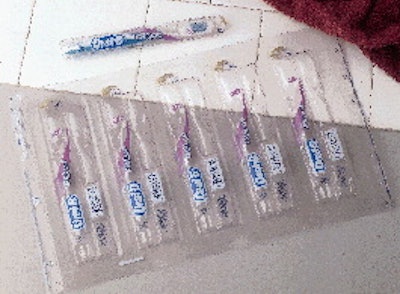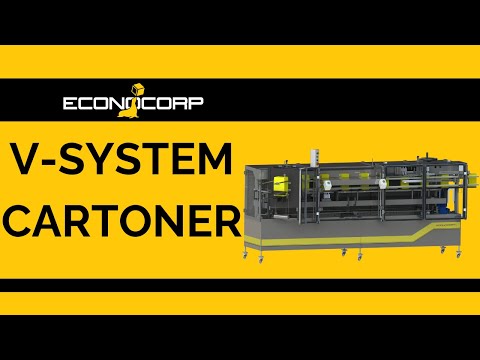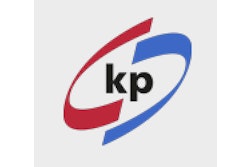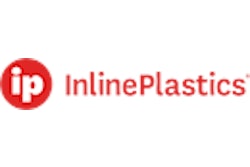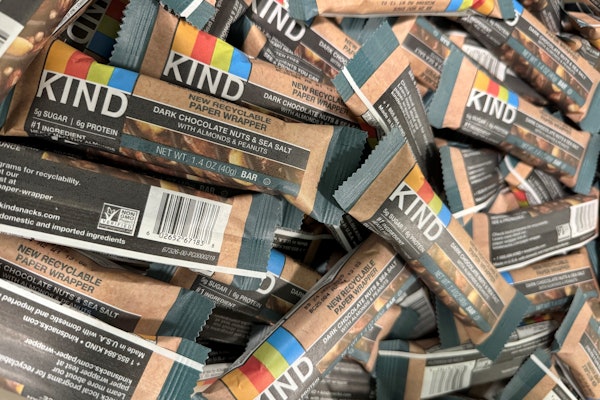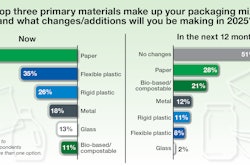The company, naturally, is excited about the brush. So enthusiastic, in fact, that the suggested retail price is $4.99. Marketing experts say this is about 50% more costly than other premium toothbrushes. While the company is clearly the sales leader in the manual toothbrush category, how big are the bets on this model?
First, Oral-B's Iowa City, IA, plant constructed a 60ꯠ-sq' addition dedicated exclusively to the manufacture and packaging of CrossAction. In addition, it has invested heavily in automating package forming and its filling and sealing line. Second, one of its suppliers on the project, CCL Label (Itasca, IL), invested $2 million in a new printing press to produce the sheetstock for the new package. Finally, by the end of '98, Oral-B had already been awarded no fewer than 22 patents on both the brush and the package. Six of these, so far, are on the package alone.
What makes the package so interesting? First, it's a transparent blister clamshell for a product category that usually uses blisters and either cards or film backs. Second, the 20-mil polyvinyl chloride clamshell is completely preprinted; there are no add-on labels. To accomplish this, Oral-B and suppliers had to develop special "stretchable" inks that could hold color even after thermoforming.
Third, to allow preprinting of even the UPC code, Oral-B had to perfect cold-forming, or more precisely, a combination of hot and cold thermoforming. This meant unusual machine and tooling technology from Sencorp, a DT Industries Co. (Hyannis, MA).
Fourth, to accommodate retailers' existing merchandising environments, the package could be no wider than 1", exactly the same width as the product. This required equipment that could form and die-cut the package in a single station. It also meant tight tolerances in the design of the hinge.
Fifth, Oral-B decided it needed to turn its production and packaging concepts upside down and create an in-line process that it calls "pellet to pallet." That refers to brush molding to palletizing of finished goods. From preprinted sheetstock in rolls, the process at Iowa City forms and cuts the clamshells and then transfers them to the loading and sealing system. After robotic indexing, the loading of brushes is also performed by a robot, and clamshells are closed and transferred into an ultrasonic welding system that currently puts four spot welds into the clamshell for hygienic seals.
Finally, the most unusual aspect of the CrossAction project is that all components were, as team leader Brad Baker calls it, "parallel-pathed." This means that while part of the development team was designing the product, other team members were simultaneously designing the package. Or as Gary Bentrim, engineering systems manager at Iowa City, puts it, "We were literally designing the package sealing system even before we had a hinge design or a package."
Creative catalyst role
The company assembled what it called its Project Discovery team, an interdisciplinary group of Oral-B people from headquarters and from the Iowa City plant. The objective was to develop a breakthrough toothbrush product and market it in a distinctive, unique and value-added package. As this evolving group looked to packaging, the company called in Kornick Lindsay (Chicago, IL), a consulting firm known for its unique package structures and designs.
"Imagine our excitement to be involved in a project where the client was asking--actually demanding--that we really stretch the envelope and look for an innovative package," says Joe Kornick, a principal at the consulting company.
"Initially, we placed very little constraint on Kornick Lindsay as they developed various concepts," recalls Brad Baker, Discovery team leader for Oral-B. "We asked them to develop a variety of structural packaging concepts that would be new to the marketplace. Then, as we moved from concept to development, we selected the top eleven or twelve for prototyping."
The team then began the first of many rounds of market research with consumers, says Diane Rooney, Oral-B's communications manager and another team leader. "The fact that we began work on packaging almost from the same time as product development speaks to the idea of partnerships and to the tremendous creativity in the early stages," she says.
In fact, Baker adds, the team couldn't really identify the package structure until after about three rounds of consumer testing. Once the team shifted from development and toward implementation, more interaction took place with manufacturing and packaging people at the plant. At that time in late spring of '97, the team made two decisions that narrowed the focus for the package: the new packaging would fit into retailers' regular toothbrush merchandising formats, and the team decided to explore the plant's experimentation with preprinted sheet.
Special forming technology
At Iowa City, Oral-B manufactures and packages all of its several lines of toothbrushes. It's heavily involved with thermoforming blisters for those products that receive the conventional lidding sealed by radio frequency heating. All of these packages--indeed all previous U.S. toothbrush packs--are believed to use labels on their packs.
To avoid this extra step, Oral-B had developed and patented a process called "cold-plug forming" that permits the use of partially preprinted sheet for thermoforming. In essence, the heated sheet of material is, in certain areas of the mold, forced into the mold with a plug assist with a cold surface temperature. The concept is to "freeze-set" the plastic by chilling its surface to avoid any deformation of the print, according to Bentrim.
"Our previous cold-plug technology had been used exclusively on flat areas of a package," he says. "On this package, the printing is also on areas of the pack that are contoured, like the Oral-B logo and the swoosh with the CrossAction name."
To get strong, unbroken print after thermoforming, CCL Label became a partner to search for an ink that could survive thermoforming without cracking. Don Foreman of CCL Label credits Bob Baum at the Sioux Falls plant for spearheading the project for the stretchable ink. "He put together a team to develop the right ink formulation and web treatment, and many trials were required before we began to approach the appearance that Oral-B demanded," Foreman says.
The materials end
Along the way, even an extensively modified printing press at CCL Label's Sioux Falls plant had to be abandoned in favor of the new flexo press that's designed for printing heavier materials like this 20-mil PVC from Klockner Pentaplast of America (Gordonsville, VA).
The company believes that the stretchable ink will find other applications, so it isn't talking much about its development, says Craig Groendyk, general manager at Sioux Falls. "We've already had conversations with several potential customers that might be able to eliminate labels or inserts by printing the forming sheet." Foreman adds that not even Oral-B knows which ink company CCL has worked with.
Currently the sheet is printed in seven colors, including two hits of white as the background for the UPC code. The code is now printed in Oral-B's signature blue, but that soon will be changed to black because of extra stations on the new press. Since the material does undergo some stretching, ink opacity is critical. However, as Groendyk explains, there are two conflicting issues: what happens as the sheet is printed and cured with UV energy, and then what happens when the sheet is formed.
The other piece supplied by CCL Label is a small fan-folded insert that's offset-printed, die-cut, folded and then affixed to clear tape that secures it near the toothbrush handle. Oral-B's Rooney recognizes the difficulty. "We feel this is an innovation, too, putting an insert around the brush handle in a package this small," she says.
Molding around product
The goal for the package was to have a clear bubble to show off the head of the brush. "We wanted the package to look like it was shaped literally around the product itself," adds Joe Kornick. "We wanted a curvilinear look to reflect the product."
Package reusability was another goal, and that steered the effort into a hinged clamshell design. So the next major challenge was creation of a durable hinge in what, he says, amounts to be virtually no space!
"We put that hinge through quite a few tests, and its design is proprietary," Bentrim says. Oral-B worked with the designer of the hinge, Inline Plastics Corp. (Milford, CT).
For now, the hinge is superfluous because the package is being sonically sealed with lock-up seals. That may change in the future.
"This is one of those subjects still being discussed between the plant people and our marketing department," Rooney says. The sealing machine can be racheted down to provide pressure seals that could be manually popped open, explains engineer Bentrim.
"There's always a trade-off," says Rooney. "You want to ensure that people aren't frustrated about gaining access to your product. But you also want the product to be well-protected at retail because you don't want consumers opening the pack to examine the brush. After all, opened packages become damaged goods." Diplomatically, she says the company is looking at a number of solutions for easy opening.
Manufacturing in cells
At the Oral-B plant, the merging of product manufacturing and packaging for the CrossAction is markedly different from other toothbrush manufacturing and packaging. In place of several manufacturing and packaging steps, each followed by inventorying, the new CrossAction brushes move directly from manufacturing into the packaging line.
The packaging begins with the Model HP1000 former from Sencorp. Printed sheet unwinds into the intermittent-motion machine. Just prior to the forming station, the supported sheet is contact-heated by a plate above the web. A registration sensor keeps the print oriented properly for the forming/cutting station. At that station, pressure and vacuum pull the sheet into the female molds while cold plugs set the plastic quickly in the print areas. Before the next cycle, the machine also cuts the five-up individual packages, leaving them attached to the web only by small tabs.
At the next station, the five packages pass over a set of bar-code scanners that verify the scannability of the bar codes. If any of the five packages don't scan, the entire sheet of five packs is rejected. The scan rates, says Bentrim, are averaging well over 98%. "I don't know of any other company that preprints a bar code before forming and has high scannability," he says. "For us, this was critical."
Afterward, the web cycles forward to the stacker station where each of the five clamshells is automatically lifted out of the skeletal web and stacked into removable magazines. When a specific count is reached, the magazine is removed and replaced by an empty one. The magazines are placed into carriers that can be wheeled to the sealing machine. Those magazines are then manually transferred from the carriers into racks on the sealer for automatic dispensing.
Loading and sealing
The Sencorp-supplied sealing system handles the clamshells three-up. A pick-and-place device loads the clamshells into fixtures that will carry them through to sealing. The pick-and-place arm motion carries the clamshell over a plate that flexes the hinge before placing it into the fixture. The partially open clamshells advance, and the small accordion-fold inserts are manually inserted into the clamshell and held in place with adhesive tape.
At another station the three packages stop, and robots transfer three brushes from an adjacent conveyor directly into the open clamshell. The Adept One robots are from Adept Technology (San Jose, CA), with engineering and software supplied by ABB Flexible Automation (New Berlin, WI).
Next, the clamshells pass a folding device on the straight-line machine that mechanically closes the blister with male/female buttons molded into the clamshell. This holds the blister in position for the sealing station where ultrasonic sealers from Branson Ultrasonics (Danbury, CT) seal the packs with four small weld points.
Finally, the machine stacks the finished packages in a Sencorp collator into a 2x3 configuration, and this group is pushed into a flight on a cartoning machine from Econocorp (Randolph, MA). The six packages are then automatically loaded into a chipboard end-loading tuck folding carton. When these boxes emerge, a worker packs them into a master shipping case, seals it and manually palletizes the case.
"The packaging equipment came on-line rather quickly," says Bentrim, "especially given the degree of automation we have. From a materials handling standpoint, this process is a major change for our plant."
Lots of partners
At the plant, Oral-B relied heavily on all of its suppliers to make the process work. In fact, Bentrim says, the line has the capacity to double "the speed of our critical path right now," so output can be dramatically increased.
"The theme of 'partnership' runs through all aspects of the CrossAction story," adds Diane Rooney. That's emphasized when Bentrim explains that the packaging department at Iowa City consists solely of himself, senior engineer Glen Smith and one support person.
Later this year, Oral-B expects to begin marketing the product overseas. The export package, however, will be a clamshell of polyester, in response to some recycling regulations in certain countries. That material has been extensively tested, Bentrim says, and sheet made from virgin polyethylene terephthalate produces an acceptable clamshell. It does cause a somewhat higher scrap rate. Sheet made from recycled PET failed to yield the clarity Oral-B sought, and consistency of molding the hinge area wasn't acceptable.
The plant began to ship the new products a few days before Christmas, and some stores began to market CrossAction shortly after the first of the year. Although Oral-B is still involved in sell-in, Rooney says the company has been very pleased with the reaction from the trade.
